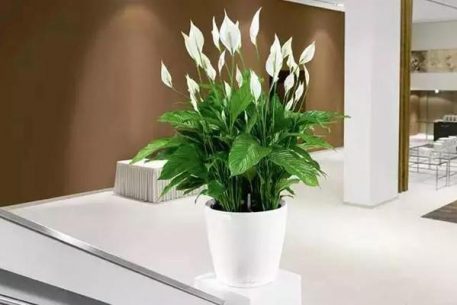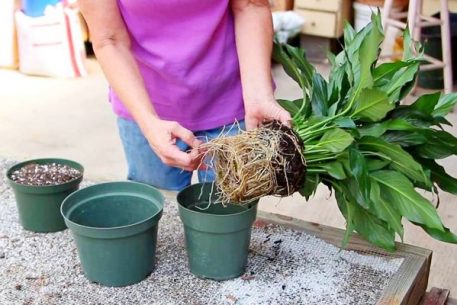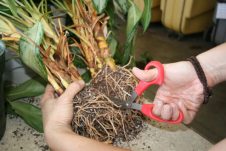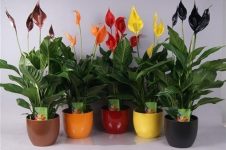The popular houseplant spathiphyllum fell on the windowsills of apartments and houses from the tropical, subtropical zones of South and Central America, Central Asia, where the perennial grows in the natural environment. The Greek name for the representative of the exotic flora is due to the original structure of the flower, resembling an ordinary wide leaf, but white in color.
Material Content:
Description of species and varieties
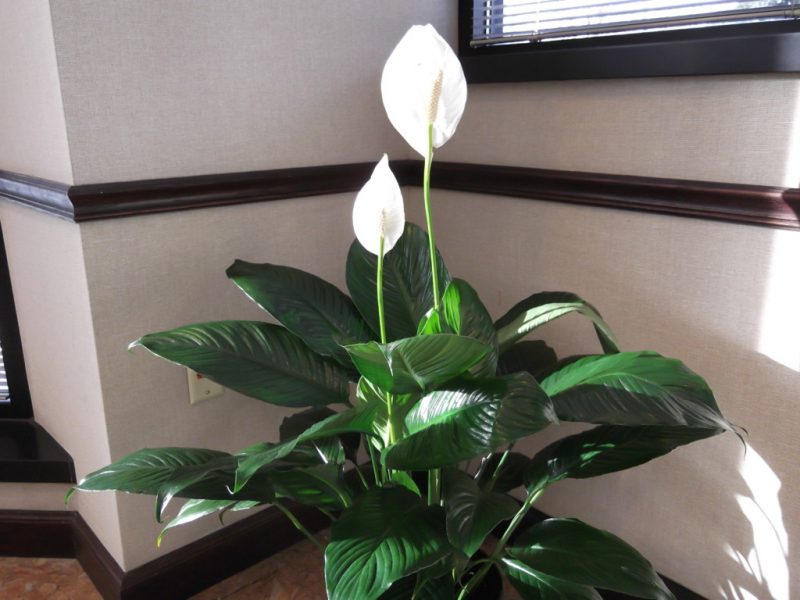
The genus of stemless plants with a basal rosette of leaves and an inflorescence-cob wrapped in a white veil has about 40 varieties in the wild, many of which have been successfully cultivated as potted flowers:
- Wallis spathiphyllum - a species with a height of 15 to 30 cm is represented by elegant bushes of elongated leaves and ears with bedspreads three times the height of the inflorescence.
- Spathiphyllum "Domino" - the form of the previous type species, characterized by a colorful pattern on leaf plates.
- Spathiphyllum "Sensation" is a tall representative of the Dutch selection, the height of which can reach 1.5 m. Wide leaves of saturated green color develop up to almost 1 m in length. The plant is often used by phytodesigners for landscaping large halls.
- Spathiphyllum is abundantly flowering - a variety native to Colombia belongs to medium-sized plants, since its bushes do not exceed a height of half a meter. It is characterized by abundant and prolonged flowering when cobs characteristic of the genus, wrapped in bedspreads, are formed.
- Heliconcelian spathiphyllum - a native of Brazil, reaches a meter height in tropical forests. Sharp ends with lengths of up to 50 cm have wavy edges. An inflorescence in the form of an ear has a length half that of a bedspread.
Growing Features
Growing an exotic plant at home requires attention to a number of botanical features of the culture, which dictate the creation of certain conditions of detention:
- Leaves. From basal leaves, a compact or spreading rosette is formed with a height of 15 to 100 cm, depending on the variety.
- Inflorescences and flowering. From spectacular leaf sockets, as a rule, in the spring flower stalks develop with inflorescences of cobs and white bedspreads at their base. Flowering lasts about 3 weeks.
- Root system. The rhizome is rather short.
In natural habitats, spathiphyllum selects a slightly acidic soil with a loose structure and a good fertile layer.
In an apartment environment, a substrate with similar indicators can be prepared from turf, leaf, peat, humus soil and sand in a ratio of 2: 1: 1: 1: 1. If necessary, you can buy a ready-made universal soil mixture in a specialized store.
Flower "Women's happiness" - how to care at home to bloom
Providing all the necessary conditions for keeping the flower grower, it will take very little time to maintain the decorativeness and health of the flower, also known in indoor floriculture as “female happiness”.
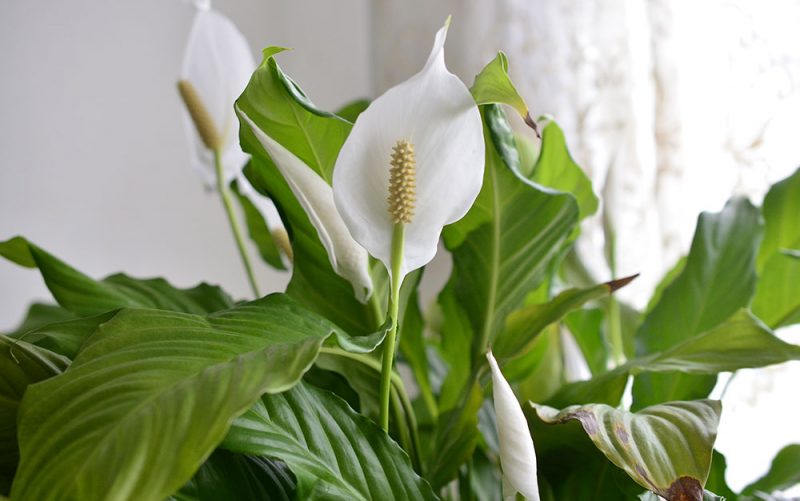
Location and lighting
Although under natural conditions spathiphyllum grows in the lower tier of tropical forests and are shade-tolerant representatives of the flora, it is recommended that they be installed in apartments in places where flowers can receive a lot of bright, diffused light that supports the decorativeness of the culture. The best option is the window sill of the east window, protected from drafts.
Temperature and humidity
The optimal temperature regime in which the spathiphyllum will be comfortable is in the spring-summer period a range of values of 18 - 24 ° C, and in winter - 16 - 20 ° C. The critical minimum is 15 ° C.
A tropical representative needs moist air, especially during the hot season or when near heating appliances. To maintain a constant level of humidity, a container with moistened pebbles should be installed next to the pot.
Watering and spraying
When spathiphyllum is observed intensive growth and flowering, it is necessary to carry out abundant watering of the flower.
In this case, moisture should not stagnate in the roots. The dried top layer of earthen coma will become a necessary signal for the next watering.
With the advent of autumn, humidification is less common. In the spring-summer period, it is recommended to systematically spray the flower and wipe the leaves with a damp sponge, which also helps to ease the respiration of the plant, eliminating the shoots from dust.
Fertilizing and fertilizers
Spathiphyllum is fed only during the active vegetation period twice a week with the help of complex mineral fertilizers in liquid form. If the flower continues to grow in the winter, you can once a month add a half dose of agrochemicals to the substrate.
Disease and Pest Prevention
An exotic plant that effectively decorates the windowsills of city apartments is resistant to pests and diseases. However, with excessive air dryness, the leaves of spathiphyllum can be inhabited by aphids and spider mites, the appearance of which can be avoided by timely wiping the leaves with a wet sponge and spraying.
If damage by insects has already been fixed, it is recommended to treat decorative bushes with an insecticidal solution. With excessive watering, the development of gray rot is often noted, which must be treated with fungicide after transplanting the plant into a fresh substrate.
Reproduction and transplantation methods
At a young age, the spathiphyllum flower is transplanted annually. After reaching its maximum size, transplantation is carried out only after the emergence of roots from the drainage holes.
During:
- A shallow pot of a slightly larger diameter is selected, on the bottom of which a drainage layer of gravel or fine brick chips is placed.
- An earthen lump with a flower is transshipped from the old tank.
- The free space is filled with fresh soil mixture.
- The plant is sprayed from the spray.
- Watering resumes after 2 to 3 days.
When transplanting, the procedure is carried out by breeding by dividing the bush, when lateral children with roots are separated from the maternal specimen and are seated in individual containers.
Important! The seed method in room conditions is practically not used due to the complexity and inability to maintain varietal qualities.
When cultivating a flower on a windowsill, flower growers sometimes encounter some problems, for the effective solution of which it is necessary to determine their cause.
Spathiphyllum leaves turn yellow and turn black - causes and treatment
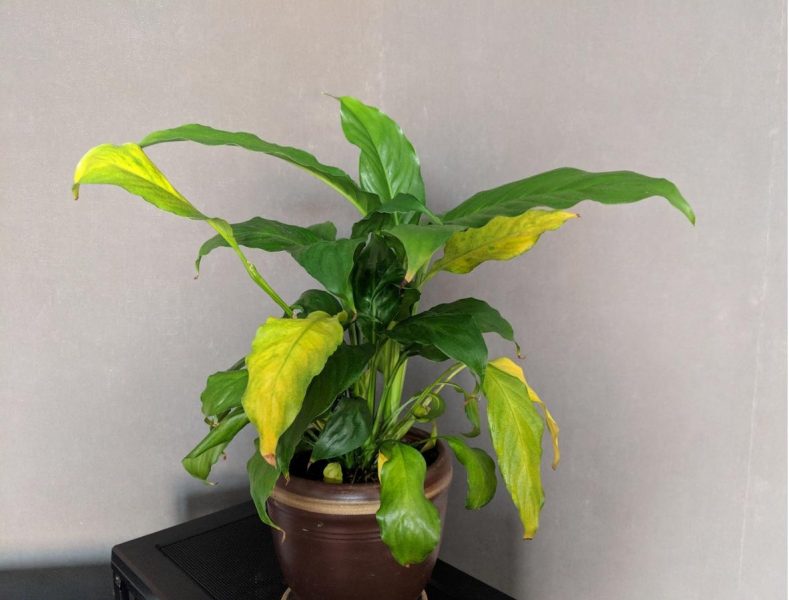
The causes of yellowing and blackening of the leaves are:
- Sucking pests, which must be controlled by spraying with a soapy solution or insecticidal (for mass population).
- Deficiency of soil and air moisture, which will normalize the irrigation regime and systematic spraying of spathiphyllum with water.
- Rot, in which the plant can be saved by transplanting it into a new container and subsequent treatment with fungicide.
Why does the flower wilt
Excessively dry or cold air, as well as a lack of nutrients, can cause the flower to wither, which, if not taken, will cause it to dry out.
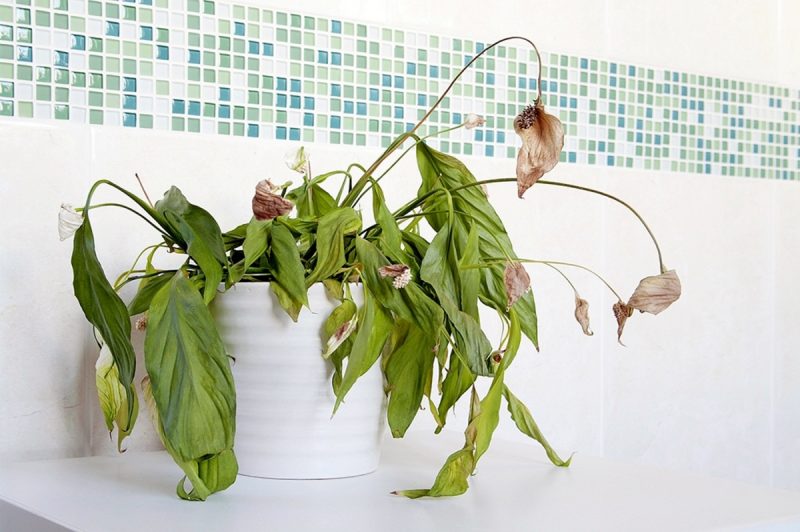
Often, flower growers are perplexed why spathiphyllum does not bloom. The lack of flowers on the plant is usually associated with such factors:
- Light deficit - if the pot is constantly in the shade, then it is worth moving it closer to the light source or organizing additional illumination.
- Too big pot - there will be no flowers until the moment when the roots are not braided by the whole earthen lump. To speed up the process, you can transplant spathiphyllum into a smaller capacity.
It is interesting:potted rosemary
Signs and superstitions associated with the flower
According to various interpretations, the flower is assigned absolutely opposite properties. Some sources claim that the flower is called “female happiness” for a reason: when a plant appears in the house, an unmarried girl living in it will soon meet a good husband. If you believe others, then spathiphyllum attracts trouble and is a husband.
However, without regard to superstition, spathiphyllum is an excellent landscaper that enriches the apartment with oxygen and requires very little care from its owner.


